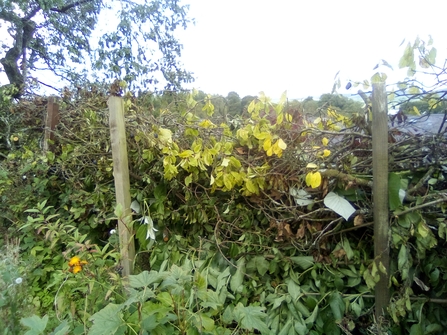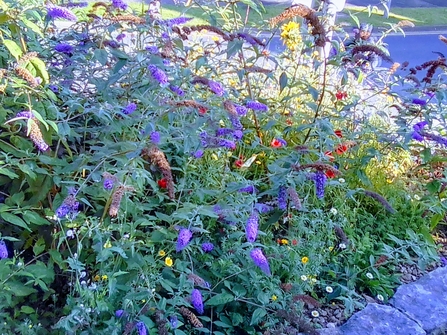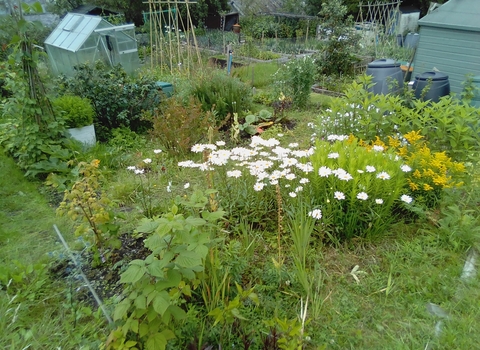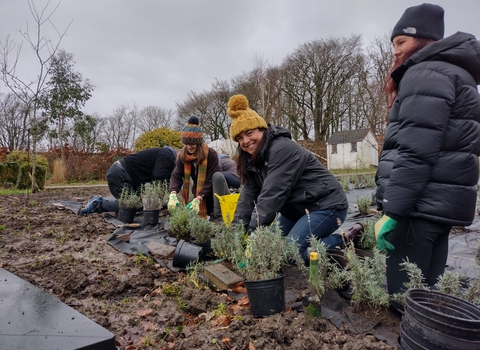
Be part of nature instead of fighting against it. That’s Jamie Smith’s approach to gardening and it’s rewarding him with a wealth of wildlife in his garden and allotment, from finches and frogs to butterflies and bats.
Don’t see weeds as a problem – every different plant will help a different creature and is part of the tapestry.
Who is it?
Jamie Smith, who lives in Kendal, grew up in a family of keen gardeners and nature enthusiasts. His degree in leisure and countryside management gave him a stronger awareness of the environment and challenges for nature, and his love of gardening and wildlife has endured through careers in hospitality and marketing. He is now writing a book on wildlife gardening.
What did they want to achieve?
Jamie is always looking for ways to help nature, and enjoys sharing his allotment and garden with wildlife. He has been working to improve biodiversity by creating habitats, food and shelter for creatures of all sizes.
How did they do it?
There are many ways to make your garden or allotment more wildlife-friendly. Here are some of the things Jamie’s done in his allotment:
-
Dead hedges
Not hedges that have died, but hedges you can build yourself. Jamie explains: “A dead hedge is where you put some posts into the ground and lay branches within to create a hedge. If you’ve been doing some pruning and have some branches left, you can place material on its side in there. They’re great because they provide habitat for birds and other creatures to live in, and the birds come and hunt for insects too.”
Ponds encourage frogs, toads and newts, and dragonflies lay their eggs in the water. Birds and small mammals will also visit ponds for a drink, and some birds will take a bath in the shallow edges.
-
Permaculture
“I practise permaculture and no-dig methods,” says Jamie. “It’s considered modern but actually existed before what we now see as traditional gardening with a fork and spade. Instead of turning the soil over, you put a mulch over it so you’re not disturbing the creatures that live underneath. They pull organic matter down to eat, and you don’t need to weed the soil.”
-
‘Weeds’
“I don’t consider ‘weeds’ to be weeds in the same way a lot of people do, because they help to build biodiversity, many actually being our native flora,” says Jamie. “Everything’s got its place. When you get that tapestry of plants with different flowers, you get pollinators coming into the area and creating that ecosystem. Instead of removing everything I haven’t planted, I’ll only take out something that’s invasive or problematic, such as Himalayan balsam.”
-
Grow fruit
Jamie has planted fruit trees and plants in his allotment. Bushes and trees provide habitat for a lot of creatures, the flowers provide food for pollinators, and the fruit itself provides food for wildlife. “I’m happy to share the fruit with the wildlife,” says Jamie. “I never use any nets or chemicals and I still get a great harvest. I love to see a blackbird flying off with a spare redcurrant for its babies.”
-
Hibernaculum
Jamie’s latest addition to his allotment is a hibernaculum – a cosy underground hibernation chamber where snakes and amphibians can spend the winter. He has put rocks, rubble, and some old bits of china piping and tree trunk in the hole, then covered it over with sticks. The pipes act as a way in and out for hibernaculum guests.
-
Pollinator-friendly planting
The allotment is completed with a wildflower area and some other pollinator-friendly planting. “It’s a fully organic, balanced ecosystem,” says Jamie. “If I do get ‘pests’ like blackfly, their predators live there too so they don’t last long.”

Dead hedge © Jamie Smith
Even in his smallish garden, Jamie’s found plenty of ways to encourage wildlife, such as a raised area full of wildflowers that’s absolutely covered with butterflies, bees and hoverflies in the summer.
One of his star wildlife attractions is his buddleia bushes, which bring in both butterflies and moths – and another winged creature: “I’ve got a street light outside the house and I’ve watched bats coming down and taking moths.”

Pollinator friendly plants including buddliea in Jamie's wildlife friendly garden © Jamie Smith
There is also a mixed native hedge that includes various species, such as lilac, wild rose and quince, attracting birds, hedgehogs and insects. “I don’t go too hard on the pruning – I only cut it if it’s in the way,” says Jamie. “This year the area had a family of sparrows and was visited by sparrowhawks and jays”.
Jamie has also built a wren roost out of old wicker baskets to encourage wrens to make a communal home for the winter.
What help did our Community Team provide?
Jamie had started to offer free wildlife gardening consultations to people because he wanted to encourage people who were keen to help the wildlife in their gardens. Around the same time, he was working as a volunteer wildlife warden at Cumbria Wildlife Trust’s Smardale Nature Reserve near Kirkby Stephen – a role that has helped him to learn more about different aspects of nature that he can incorporate in his own garden and allotment. “I got to do a few day courses on subjects such as fungi identification, and doing surveys on wildflowers,” said Jamie. “Those were really interesting and helpful.”
His latest volunteer role with Cumbria Wildlife Trust is writing the Wildlife Gardening e-newsletter. Subscribe for the latest seasonal tips from Jamie, and look at our resources if you need a hand getting started with your own wildlife garden.
If I do get ‘pests’ like blackfly, their predators live there too so they don’t last long.
What was the outcome?
The action Jamie has taken in his allotment and garden shows what’s possible, and he loves to share what he’s learned.
“A wildlife garden is a low-maintenance garden,” he said. “Don’t see weeds as a problem – every different plant will help a different creature and is part of the tapestry. I’m letting nature and the species within it do their thing naturally. When people work against nature – obsessive weeding, keeping every part of the lawn short just so it’s tidy – that’s high maintenance. Relax a bit. Enjoy observing the life you share your garden with. If you leave the leaves, they’re not going to break into your house and steal your wine overnight.”
Creating an ecosystem starts with the little things. If you leave a pile of logs, fungi develops, the invertebrates come and make homes and eat them, then the next creature up the food chain comes to the area to feast and make a home - such as a frog or bird - and so it continues.









